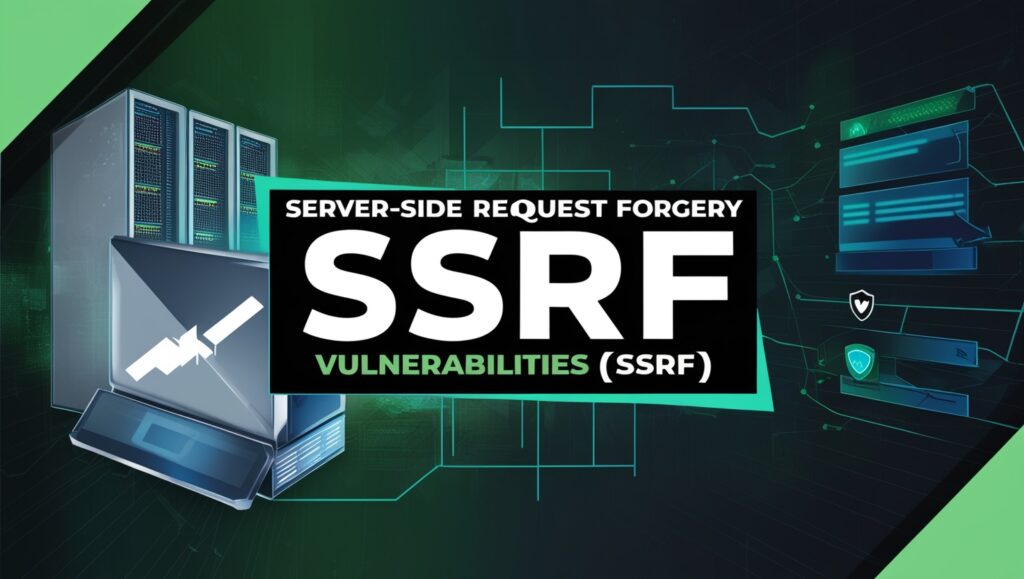1. Introduction
In the world of cybersecurity, one of the critical vulnerabilities affecting web applications is Server-Side Request Forgery (SSRF). This vulnerability allows attackers to trick a server into making unauthorized requests to internal or external resources.
SSRF occurs when a web application fetches resources from a user-supplied URL without proper validation. The attacker can exploit this behavior to access sensitive data, perform port scans, or even interact with internal services that are otherwise inaccessible.
Due to its potential to bypass firewalls and access private resources, Server-Side Request Forgery (SSRF) has become a major concern for developers and security experts alike. In this blog, we will dive deep into SSRF, exploring its technical details, vulnerabilities, exploitation techniques, and ways to mitigate it effectively.

2. Technical Explanation
Server-Side Request Forgery (SSRF) is a web application vulnerability where the attacker manipulates the server to send requests to unintended destinations.
The vulnerability arises when an application accepts a URL or IP address as input and makes requests without verifying its authenticity.
Example of SSRF Flow:
- An application allows users to upload files by providing a URL to fetch the file.
- The attacker supplies a malicious URL like
http://localhost/adminorhttp://127.0.0.1:8080. - The server fetches the resource from the provided URL, inadvertently exposing sensitive information or performing unintended actions.
This occurs because servers often have access to internal networks or privileged services, which users cannot access directly.
3. SSRF Vulnerabilities in Depth
3.1. Common Targets for SSRF
- Internal Networks: SSRF can exploit private networks, allowing attackers to scan for open ports or services.
- Metadata Services: In cloud environments like AWS, SSRF can retrieve sensitive metadata from services like
http://169.254.169.254. - Databases and APIs: Attackers can interact with backend systems and APIs by injecting malicious requests.
3.2. Blind SSRF vs. Regular SSRF
- Regular SSRF: The attacker gets immediate feedback from the server, such as the requested content or error messages.
- Blind SSRF: The server does not provide direct feedback, making the attack more challenging but still possible using out-of-band (OOB) techniques like DNS logging.
3.3. SSRF and Cloud Environments
In cloud setups, SSRF can access metadata services to retrieve sensitive details like access keys, instance IDs, and user data, leading to privilege escalation and other attacks.
4. Exploitation Techniques
Attackers use several methods to exploit Server-Side Request Forgery (SSRF) vulnerabilities:
4.1. Exploiting Internal Resources
By targeting internal endpoints like http://127.0.0.1 or http://localhost, attackers can access private systems or perform internal scans.
4.2. Bypassing Validation
Developers often implement URL validation to prevent SSRF attacks, but attackers can bypass these checks using techniques like:
- Encoding the URL: Using URL-encoded formats like
%25%32%30to bypass blacklist filters. - Redirects: Using open redirect vulnerabilities to mask malicious URLs.
4.3. Metadata Exploitation
In cloud environments, SSRF is commonly used to query metadata endpoints (e.g., http://169.254.169.254/latest/meta-data/) to extract sensitive credentials and configurations.
4.4. DNS Rebinding
Attackers can use DNS rebinding to force the server to resolve an external domain to an internal IP address, bypassing restrictions.
5. Prevention and Mitigation
Securing applications against Server-Side Request Forgery (SSRF) requires a combination of best practices:
5.1. Input Validation
- Validate user-supplied URLs using allowlists.
- Reject private or loopback addresses such as
127.0.0.1,localhost, and10.0.0.0/8.
5.2. Restrict Network Access
- Use network segmentation to restrict server access to sensitive internal resources.
- Implement firewall rules to block unnecessary outgoing requests.
5.3. Use Libraries and Tools
- Leverage security tools like Web Application Firewalls (WAFs) to detect and block SSRF attempts.
- Use libraries that validate and sanitize user input before processing it.
5.4. Monitor and Log Requests
Monitor outgoing requests for anomalies, such as unexpected internal network traffic, and maintain detailed logs to detect potential SSRF activity.
6. Case Studies and Tools
6.1. Famous SSRF Vulnerabilities
- Capital One AWS Breach (2019): An SSRF vulnerability was used to access AWS metadata, leading to the exfiltration of over 100 million records.
- Tesla Bug Bounty (2020): Researchers found SSRF vulnerabilities in Tesla systems, demonstrating access to internal services.
6.2. Tools for SSRF Testing
- Burp Suite: Use the Repeater and Intruder modules to test SSRF vulnerabilities.
- FFUF: Fuzz URLs for potential SSRF endpoints.
- SSRFmap: Automates SSRF testing and exploitation.
These tools can help penetration testers and security researchers identify and exploit SSRF vulnerabilities effectively.
7. Conclusion
Server-Side Request Forgery (SSRF) is a critical web application vulnerability that can have devastating consequences if left unaddressed. By exploiting SSRF, attackers can access internal systems, retrieve sensitive data, and compromise application security.
Developers must take proactive steps to secure their applications by validating inputs, restricting network access, and monitoring outgoing requests. Leveraging tools like Burp Suite and SSRFmap can also help identify and patch SSRF vulnerabilities during testing.
With the rising adoption of cloud services, the importance of addressing SSRF vulnerabilities is greater than ever. Stay vigilant, implement best practices, and protect your applications from the risks posed by Server-Side Request Forgery (SSRF).
Check More Blog:- https://thetechcrime.com/mobile-app-pentesting/
Check My YouTube Chenal:- https://www.youtube.com/@Thetechhacker231

Leave a Reply